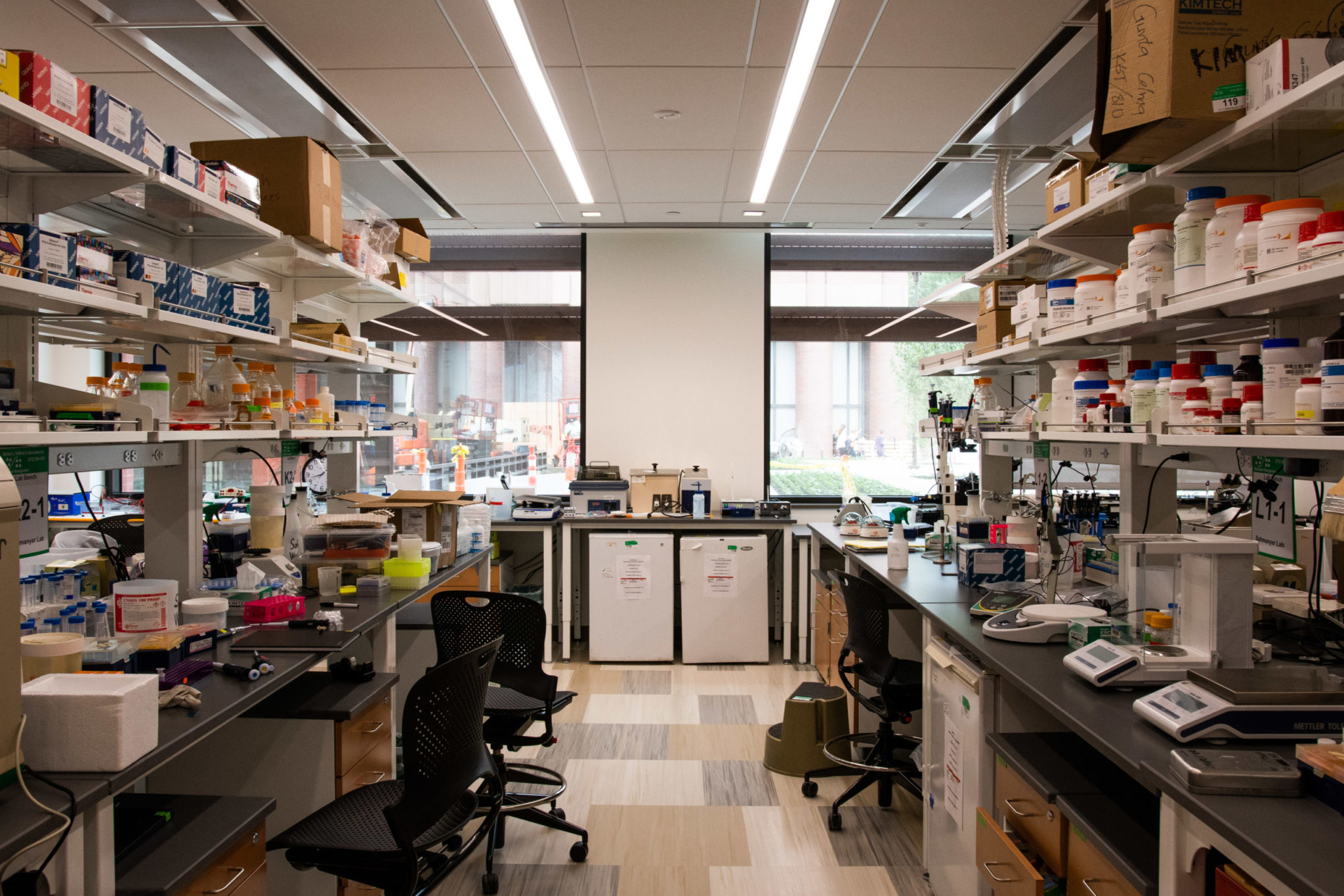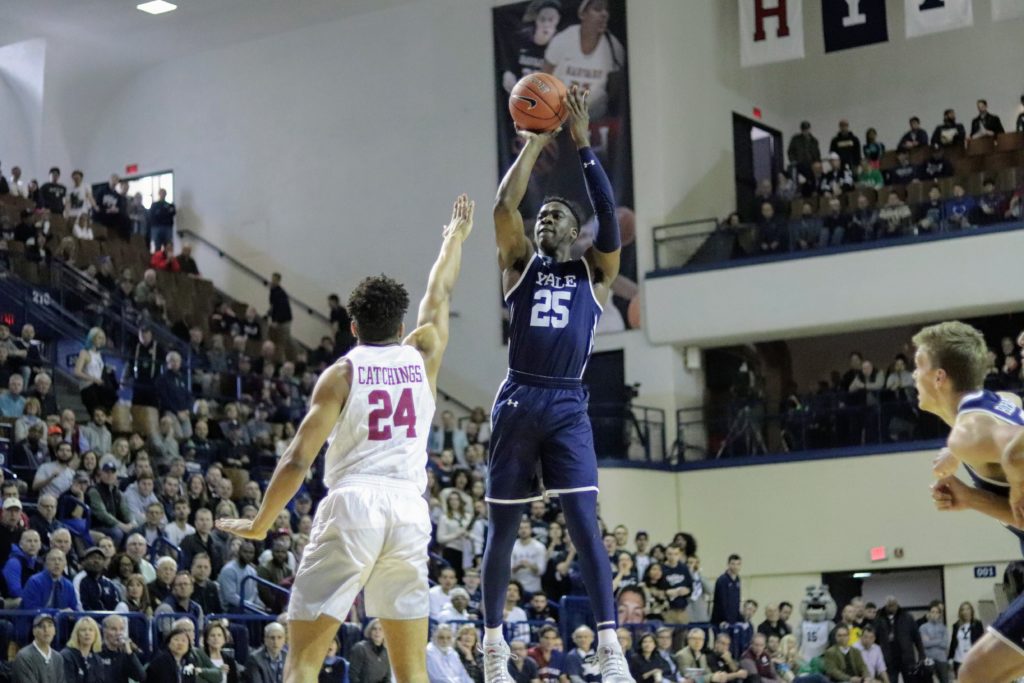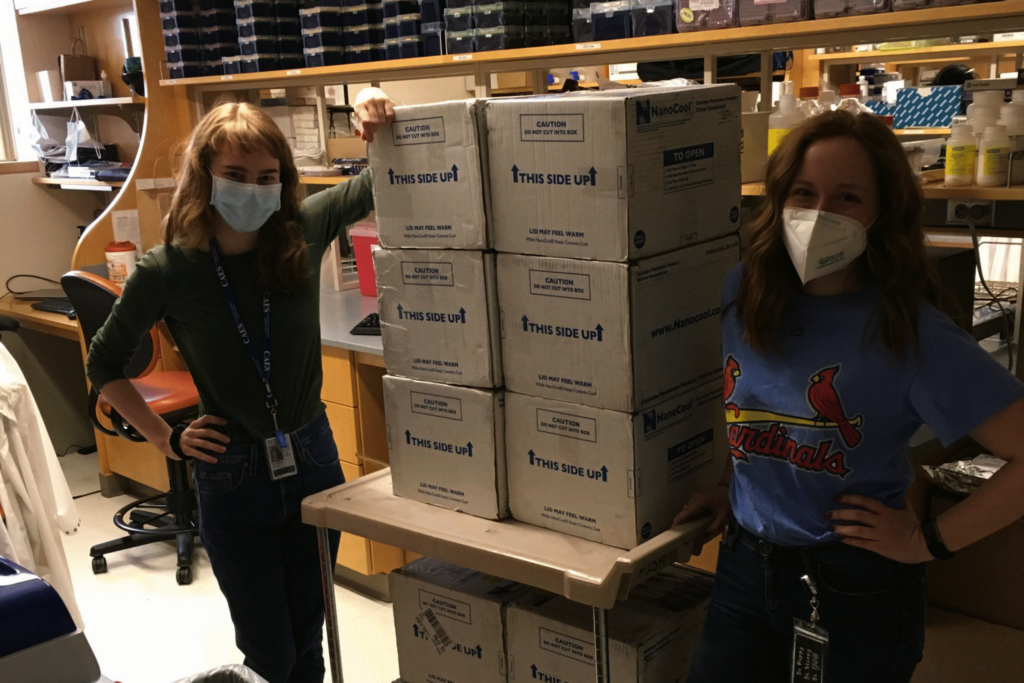Spit and “SWISH”: Inside the NBA-Yale partnership aiming to validate a saliva-based test for COVID-19
School of Public Health researchers hope testing with the NBA can verify the accuracy of SalivaDirect.

Lukas Flippo
In April, when associate research scientist in epidemiology Anne Wyllie and her team at Yale released a potentially seminal preprint on saliva testing for SARS-CoV-2, their inboxes exploded. Their results suggested that using saliva samples could be more sensitive than results from the widely used nasopharyngeal (NP) swabs.
Excitement around the early finding was palpable — an accurate saliva-based test could complement, or even replace, the gold standard of NP swabs. The Wall Street Journal requested an interview. The New York Times published a story. The News also wrote about their findings.
And then, one day in mid-May, the NBA emailed. They wanted to talk.
Robby Sikka, vice president of basketball performance and technology for the Minnesota Timberwolves and a physician, sent the note, sparking a month of Zoom meetings and collaborative calls that occasionally stretched into the early hours of morning. The NBA and the National Basketball Players Association — busy plotting out the logistics of a potential return to competition — soon hatched a plan with Yale researchers to verify their saliva-based test, which is called SalivaDirect.
The partnership will ideally lead to a global increase in testing capacity, said Nathan Grubaugh, an assistant professor of epidemiology and a joint senior author on the initial preprint. Grubaugh’s lab, which typically studies mosquito-borne viruses, is calling the project “SWISH,” the Surveillance with Improved Screening and Health study.
“It was clear that [the NBA] wanted to use saliva to test players and staff because people don’t want to get these nasal swabs every day,” Grubaugh said. “But also, they saw how saliva could be used in a way to help increase testing capacity … They’re really keen on it, and then they also have this population of people that cannot social distance or wear masks by the nature of their job. And so to keep them safe, they have to do very regular testing.”
Frequent testing — and the infrastructure to support it — presents an enticing research opportunity for scientists. The partnership allows NBA players, coaches and staff who opt-in to supplement their required testing regimen with an extra step that will help bring SalivaDirect closer to public use. Grubaugh said that their team is preparing to apply for emergency use authorization from the Food and Drug Administration with the goal of making the test ready for public use by as early as mid-July. Comparing saliva test results to those that originate from the NBA’s regular testing will help validate the effectiveness of SalivaDirect.
In addition to the saliva samples, Wyllie explained that the NBA will provide the de-identified demographic information of the players, and testing will reveal positive COVID-19 rates among teams that participate. This information will allow for another Yale epidemiological study, which is being spearheaded by Harlan Krumholz, director of the Yale Center for Outcomes Research & Evaluation (CORE) and Cesar Caraballo-Cordovez, a postdoctoral associate at CORE. Albert Ko, chair of the Department of Epidemiology of Microbial Diseases, is also part of the Yale team working with the NBA.
The NBA is funding the SalivaDirect study as well as the aforementioned epidemiological investigation, according to Wyllie and Grubaugh.
Saliva-Based Testing
Although Wyllie said the NBA will provide demographic information, actual testing data will be de-identified. Twelve to 16 NBA teams, including players, coaches and staff members, will have the opportunity to participate in the study, but Grubaugh said Yale researchers will not know the teams or individuals they are testing. His lab, for example, will have no way of telling whether former Yale guard Miye Oni, who signed his first NBA contract last July with the playoff-bound Utah Jazz, is a study participant.

Players and staff who choose to enroll in the study will still receive NP and oropharyngeal (OP) swabs for testing every other day as part of standard NBA protocol, Grubaugh said, before providing a saliva sample at a research booth afterwards. Nasal and oral swabs — the official tests — are sent to Quest Diagnostics, while saliva samples are overnighted to New Haven. Then, Yale will compare the results of its SalivaDirect sample with the results of the swab tests. Partnering with the NBA will allow them to validate the SalivaDirect test with a large asymptomatic cohort, according to Wyllie.
The NBA, meanwhile, may launch a transition from nasal and oral swab testing to SalivaDirect in their certified facilities, if the method’s accuracy remains high and researchers receive authorization from the FDA. Using saliva could offer promising benefits for the cost, scope and comfort of coronavirus testing, researchers said.
In the preprint of their initial study, which was released on April 22, Wyllie, Grubaugh and their team used data collected over the course of six weeks from saliva samples of healthcare workers and inpatients at Yale New Haven Health.
“Saliva is a more consistent and easier test to take and always lower risk, and it saves time and PPE,” Wyllie said at the time of preprint’s publication. “It could be really transformative for our testing efforts at the moment in a healthcare setting.”
And as Grubaugh pointed out, saliva-based testing is more comfortable for patients than using a deep nasal swab, which stretches all the way to the top of the throat. In a situation where testing must occur nearly every single day — like in the NBA’s planned Orlando, Florida “bubble” or on a college campus — continually using NP swabs is a nuisance, Grubaugh said. Utah Jazz star Donovan Mitchell, who was the second NBA player to test positive for the coronavirus, told Good Morning America in March that the NP swab test was “15 seconds of probably the most discomfort I’ve ever had,” though he felt glad to have received and taken a test.
The original saliva testing method — which was featured in the preprint — involved spitting into a cup, followed by RNA extraction from the saliva and the RT-PCR test approved by the Centers for Disease Control and Prevention. While the sample was easier to collect than a nasopharyngeal swab, the RNA extraction still made the process time consuming and potentially expensive.
Since the April paper was published, researchers have modified the saliva testing method. Wyllie said she and Grubaugh figured out how to remove the RNA extraction step entirely, significantly lowering the cost of each test.
“We’ve called it SalivaDirect because of the idea that we’re almost testing saliva directly. We’re doing a very simple intermediate treatment, and then testing that directly with RT-PCR,” Wyllie said. “That makes it a lot cheaper and makes it a lot more high throughput and faster turnaround.”
She added that the goal is to assess the efficacy of the test on a number of different RT-PCR machines as well as with many commonly available reagents.

The NBA’s Planned Return
The study began on Tuesday, June 23, and the Yale team received first samples on Wednesday. Grubaugh told the News he was estimating between 300 and 500 people would enroll in the study. Their work is scheduled to occur before NBA teams travel to Orlando, Florida — home of Walt Disney World, the NBA’s makeshift campus.
The NBA sent a 113-page memo on “Health and Safety Protocols” to players, coaches and staff last Tuesday, according to The Athletic, detailing precautions to prevent the spread of COVID-19. Guidance ranged from grand instructions about arrivals and departures — chartered transportation will stagger the movement of teams from their home cities to Disney between July 7 and 9 — to the minutiae of everyday life in the NBA bubble, where doubles are forbidden in ping pong and decks of cards must be disposed after one use.
The memo included news about the voluntary Yale study, Grubaugh said, and players have the option to participate during at least the early phases of the NBA’s return-to-play plan. For the next two weeks, samples will travel from various NBA training facilities across the nation to New Haven for evaluation. After two weeks, new decisions will be made about the future of the investigation when NBA players all transition to Orlando, according to Wyllie.
“This is while all the teams are still… in their home cities, they’re getting back into practices, getting back into training … leading up to Florida, where they’re all going to come together,” Wyllie said. “The fact that we can sort of piggyback off the logistics that the NBA already has in place like with their daily testing and the logistics they have for data collection and sending a sample makes it a lot easier for us to put this cohort study into place. This can require a lot of money and time and work to do that otherwise.”
Wyllie and Grubaugh stressed that their long term goal with SalivaDirect is not commercialization, and they have already published their testing protocol online as an open source.
By testing SalivaDirect with many types of commonly available equipment and reagents, Wyllie says their hope is to let the public know how to best carry out the test, without being limited to one company or one testing kit. For groups like the NBA who want to test their players, coaches and staff, having to rely on one company means that they are dependent on their supply chains and can suffer when the company decides to increase its prices, according to Wyllie.
As the virus continues to spread, Sikka noted that testing bottlenecks will inevitably appear in cities around the country, hindering testing efforts at potentially critical junctures. A saliva-based test could prevent them.
“What we’re trying to do is to make it affordable and accessible to everybody. We’re really just focusing on trying to get testing down to a couple of dollars per test,” Wyllie said. “If we want to go forward and have colleges come back or schools come back… [or] if you’ve been thinking about things in an inner city situation… having affordable testing is really important.”
In fact, Grubaugh said that one of the NBA’s longer-term goals with the partnership is to eventually open clinical testing sites. The details still need to be worked out, but the NBA hopes to provide free saliva-based testing to low-income individuals in the U.S., Grubaugh said. In an email to the News, Joanna Shaprio, the league’s senior director for communications, said she was currently unable to comment on the possibility of public testing sites.

For Grubaugh, who considers himself a big sports fan, the convergence of his research and the NBA’s highly-publicized public health planning has been engrossing. For the first time ever, ESPN has become a source of information for his work — and other members of the sports media have leaked it. NBA Insider Shams Charania was the first to publicly report on the NBA’s partnership with the Yale School of Public Health, citing a confidential source in a Tweet last week.
“From a personal perspective, it’s really cool to be a part of it,” Grubaugh said. “I never really thought about mixing sports and work, so I’m excited to do it … It’s going to be a lot of fun watching this and knowing that I’m a part of it but … I don’t know if I can ever disconnect anymore between watching the game now and thinking, ‘Hmm, was this person positive?’”
Chaney Kalinich ’19 MPH ’20 MED ’24, a postgraduate researcher in the Grubaugh Lab, had never previously considered herself an NBA fan. A Chicago native, she had been frustrated with the Bulls and injury-prone Derrick Rose. But contributing to the study — and her perspective on precautions the league is taking in its preparation for a return to play — has changed that.
She expects to help “fill in the cracks” with the study and assist lab technicians with sampling, while she simultaneously works on making SalivaDirect more efficient by running temperature stability experiments and constantly communicating data to the public via the lab’s website.
“I read recently somebody saying that an epidemiologist’s job, 90 percent of the time, is to just say ‘it depends’ to things,” Kalinich said. “That’s sort of the way that we have to respond to sports coming back. Should we have sports again? It depends on whether it’s being done the right way, and I really think the NBA is doing it the right way … I guess we’ll see how it pans out, but I think [their plan] poses a really good model for not even just professional sports but once we have the testing capacity, hopefully college sports and all levels.”
The NBA’s investment in public health and improved testing also impressed Kalinich, who played field hockey for the Bulldogs.
Still, no bubble is perfect, Grubaugh said. Disney staff, for example, will still need to enter and exit the bubble, and although the NBA is taking painstaking precautions, the risk of transmission remains. A spike in cases across Florida, where more than 5,000 new cases were identified on Wednesday, could spoil the NBA’s return before teams even arrive.
Twenty two of the NBA’s 30 teams are set to participate in the resumed season with official competitions at Disney beginning on July 30.
William McCormack | william.mccormack@yale.edu
Charlotte Zimmer | charlotte.zimmer@yale.edu







